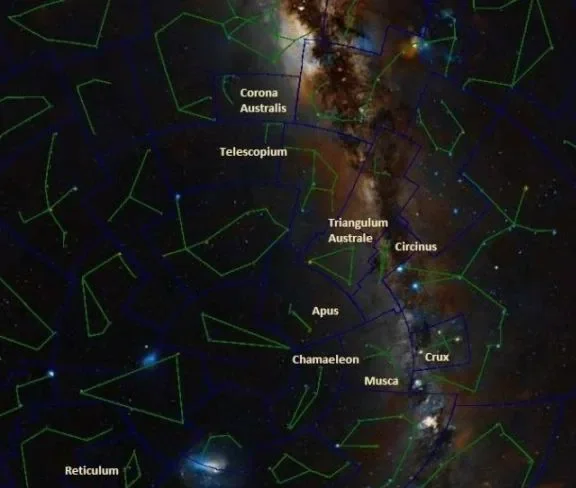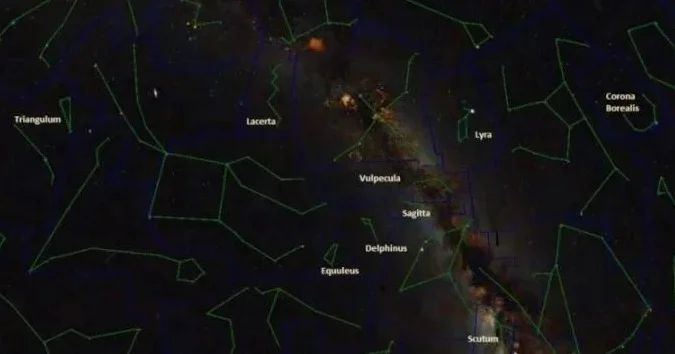The smallest constellations in the sky are Crux, Equuleus, Sagitta, Circinus and Scutum. The smallest northern constellations are Equuleus, Sagitta, Triangulum, Corona Borealis and Canis Minor, and the southern ones are Crux, Circinus, Scutum, Triangulum Australe and Reticulum.
While many of the smallest constellations are also among the faintest and least distinct, this is not the case with all of them. Crux, the Southern Cross, is one of the best known constellations in the sky. It is used in navigation to find true north and its bright stars are featured on the flags of several countries and territories. Three of the constellation’s five brightest stars are among the 25 brightest stars in the sky. However, while the constellation is one of the most familiar patterns to observers in the southern hemisphere, it is invisible to northern observers living north of latitude 20°N.

The smallest southern constellations, image: Wikisky
North of the celestial equator, the constellations Corona Borealis, Triangulum and Canis Minor are relatively easy to spot on a clear night. Corona Borealis has a distinctive semi-circular asterism representing the Northern Crown that makes it easy to find between the larger Hercules and Boötes. Triangulum‘s long narrow triangle is easy to locate between the bright stars of Andromeda and Aries constellations. Canis Minor is easily identified because it is home to Procyon, one of the brightest stars in the sky and one of the vertices of the Winter Hexagon and Winter Triangle asterisms.

The smallest northern constellations, image: Wikisky
Equuleus and Sagitta, the 2nd and 3rd smallest constellations, lie in the same area of the northern sky and are separated by Delphinus, another small constellation with a distinctive shape. All three are Greek constellations, listed by Ptolemy in his Almagest. While Equuleus is quite faint and indistinct, Sagitta can be identified in good conditions. Its shape resembles that of an arrow and it can be found between the two large northern birds: Cygnus and Aquila.
Many of the smallest constellations in the sky are those introduced by the German uranographer Johann Bayer in the early 17th century and French astronomer Nicolas-Louis de Lacaille in the 18th century. These constellations are located in the southern celestial hemisphere and due to their position far south they remained unknown to northern observers until the Age of Discovery.
Most of these constellations are named after instruments (Circinus, Reticulum, Caelum) or exotic animals (Chamaeleon, Volans, Dorado). Those introduced by Bayer were created by the Dutch-Flemish cartographer Petrus Plancius based on observations of Dutch explorers and are named after various animals they encountered on their journeys. The constellations created by Lacaille, on the other hand, represent various scientific instruments. As many of these constellations are invisible to northern observers living north of tropical latitudes, they are still largely unknown in the northern hemisphere.
Below is the list of the 88 modern constellations ordered by size, from smallest to largest.
| Constellation | Size (area in square degrees) | Quadrant |
| 1. Crux | 68.447 | SQ3 |
| 2. Equuleus | 71.641 | NQ4 |
| 3. Sagitta | 79.932 | NQ4 |
| 4. Circinus | 93.353 | SQ3 |
| 5. Scutum | 109.114 | SQ4 |
| 6. Triangulum Australe | 109.978 | SQ3 |
| 7. Reticulum | 113.936 | SQ1 |
| 8. Caelum | 124.865 | SQ1 |
| 9. Corona Australis | 127.696 | SQ4 |
| 10. Chamaeleon | 131.592 | SQ2 |
| 11. Triangulum | 131.847 | NQ1 |
| 12. Musca | 138.355 | SQ3 |
| 13. Volans | 141.354 | SQ2 |
| 14. Mensa | 153.484 | SQ1 |
| 15. Norma | 165.290 | SQ3 |
| 16. Corona Borealis | 178.710 | NQ3 |
| 17. Dorado | 179.173 | SQ1 |
| 18. Canis Minor | 183.367 | NQ2 |
| 19. Corvus | 183.801 | SQ3 |
| 20. Delphinus | 188.549 | NQ4 |
| 21. Lacerta | 200.688 | NQ4 |
| 22. Apus | 206.327 | SQ3 |
| 23. Microscopium | 209.513 | SQ4 |
| 24. Pyxis | 220.833 | SQ2 |
| 25. Leo Minor | 231.956 | NQ2 |
| 26. Ara | 237.057 | SQ3 |
| 27. Antlia | 238.901 | SQ2 |
| 28. Hydrus | 243.035 | SQ1 |
| 29. Piscis Austrinus | 245.375 | SQ4 |
| 30. Pictor | 246.739 | SQ1 |
| 31. Horologium | 248.885 | SQ1 |
| 32. Telescopium | 251.512 | SQ4 |
| 33. Ursa Minor | 255.864 | NQ3 |
| 34. Vulpecula | 268.165 | NQ4 |
| 35. Columba | 270.184 | SQ1 |
| 36. Crater | 282.398 | SQ2 |
| 37. Lyra | 286.476 | NQ4 |
| 38. Lepus | 290.291 | SQ1 |
| 39. Octans | 291.045 | SQ4 |
| 40. Indus | 294.006 | SQ4 |
| 41. Tucana | 294.557 | SQ4 |
| 42. Sextans | 313.515 | SQ2 |
| 43. Lupus | 333.683 | SQ3 |
| 44. Grus | 365.513 | SQ4 |
| 45. Pavo | 377.666 | SQ4 |
| 46. Canis Major | 380.118 | SQ2 |
| 47. Coma Berenices | 386.475 | NQ3 |
| 48. Fornax | 397.502 | SQ1 |
| 49. Capricornus | 413.947 | SQ4 |
| 50. Aries | 441.395 | NQ1 |
| 51. Canes Venatici | 465.194 | NQ3 |
| 52. Phoenix | 469.319 | SQ1 |
| 53. Sculptor | 474.764 | SQ1 |
| 54. Monoceros | 481.569 | NQ2 |
| 55. Carina | 494.184 | SQ2 |
| 56. Scorpius | 496.783 | SQ3 |
| 57. Vela | 499.649 | SQ2 |
| 58. Cancer | 505.872 | NQ2 |
| 59. Gemini | 513.761 | NQ2 |
| 60. Libra | 538.052 | SQ3 |
| 61. Lynx | 545.386 | NQ2 |
| 62. Cepheus | 587.787 | NQ4 |
| 63. Orion | 594.120 | NQ1 |
| 64. Cassiopeia | 598.407 | NQ1 |
| 65. Perseus | 614.997 | NQ1 |
| 66. Serpens | 636.928 | NQ3 |
| 67. Aquila | 652.473 | NQ4 |
| 68. Auriga | 657.438 | NQ2 |
| 69. Puppis | 673.434 | SQ2 |
| 70. Andromeda | 722.278 | NQ1 |
| 71. Camelopardalis | 756.828 | NQ2 |
| 72. Taurus | 797.249 | NQ1 |
| 73. Cygnus | 803.983 | NQ4 |
| 74. Sagittarius | 867.432 | SQ4 |
| 75. Pisces | 889.417 | NQ1 |
| 76. Boötes | 906.831 | NQ3 |
| 77. Leo | 946.964 | NQ2 |
| 78. Ophiuchus | 948.340 | SQ3 |
| 79. Aquarius | 979.854 | SQ4 |
| 80. Centaurus | 1060.422 | SQ3 |
| 81. Draco | 1082.952 | NQ3 |
| 82. Pegasus | 1120.794 | NQ4 |
| 83. Eridanus | 1137.919 | SQ1 |
| 84. Hercules | 1225.148 | NQ3 |
| 85. Cetus | 1231.411 | SQ1 |
| 86. Ursa Major | 1279.660 | NQ2 |
| 87. Virgo | 1294.428 | SQ3 |
| 88. Hydra | 1302.844 | SQ2 |